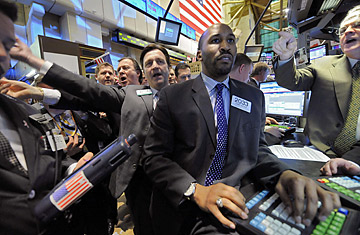
Traders work on the floor of the New York Stock Exchange
Here we go again. After late-December market action suggested that a decent rally was gaining steam, the stock market appears to be returning to its November queasiness.
Since Jan. 2, the Standard & Poor's 500 index has given back roughly half of the 24% gain it had logged since mid-November's low of 741. The financial news, spiked with bankruptcies, bank losses, surging foreclosures, rising unemployment and a slew of lifestyle stories on how to live on less, is unnerving investors. On Thursday they confirmed their wariness by taking the Dow Industrials below 8000 briefly before boosting the index back to close at 8212, up 12.35 points on the day.
Most troubling to the financial markets is the ongoing question surrounding the nation's biggest banks, including reports that Bank of America's acquisition of Merrill Lynch is shaky and that BofA will need billions more in federal assistance. Meanwhile, Citigroup is trying to stay one step ahead of the sharks, er, shorts, who have taken the stock down more than 20% in the past two days. Though Citi is moving aggressively to hive off assets and divisions — earlier this week it announced the merger of its Smith Barney brokerage unit with Morgan Stanley's Global Wealth Management division, a deal that will bring Citi more than $2 billion — investors are worried about worsening loan losses across the banking sector and also about Citi's ability to get decent prices on any other asset sales. Even JPMorgan Chase, which reported a small fourth-quarter profit of $702 million, was the bearer of troubling news, as CEO Jamie Dimon spoke of more hard times to come. "The worst of the economic situation is not yet behind us," he said, noting that the bank's most worrisome businesses going forward are consumer loans and credit cards. (See pictures of scared traders.)
So are stocks headed back to the lows of mid-November, when the Dow sank to 7552? A further decline of 5% or so from Thursday's lows would put the market back near the November bottom. For stock-market technicians, a so-called double bottom, or return to prior lows, can be a healthy sign of base-building, which can set the stage for a sustained advance. But there are special risks related to any such swoon this time around: Bank stocks are among the market's weakest, and a further drop in their shares could place these institutions in jeopardy. Further, another steep decline in stocks could trigger a new round of redemptions from hedge funds, which in turn could lead to more selling.
For bottom fishers, the message is clear: This is no time for casual market-dabbling with your portfolio. Be either a lightning-fast stock trader or a very-long-term investor.
